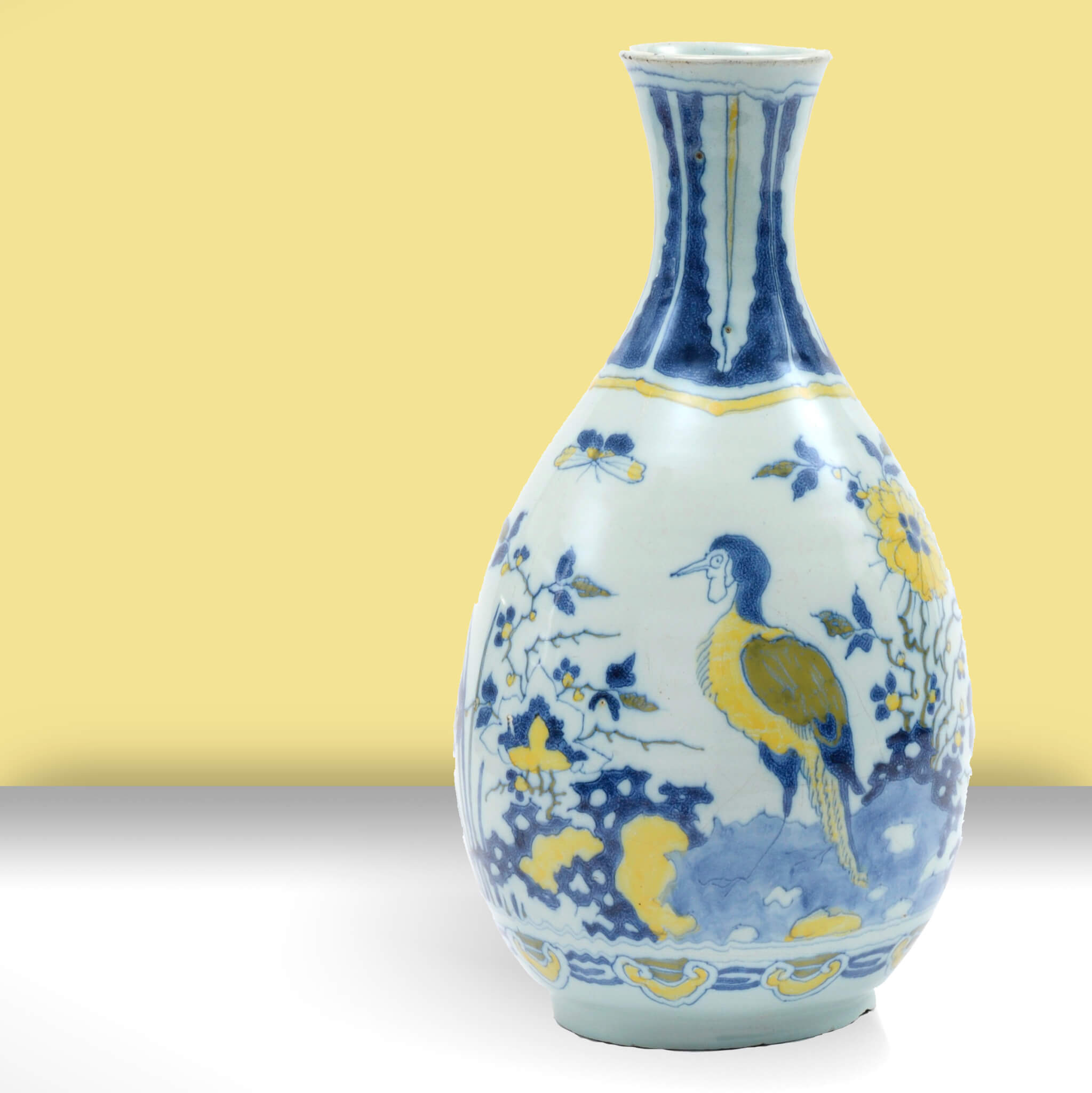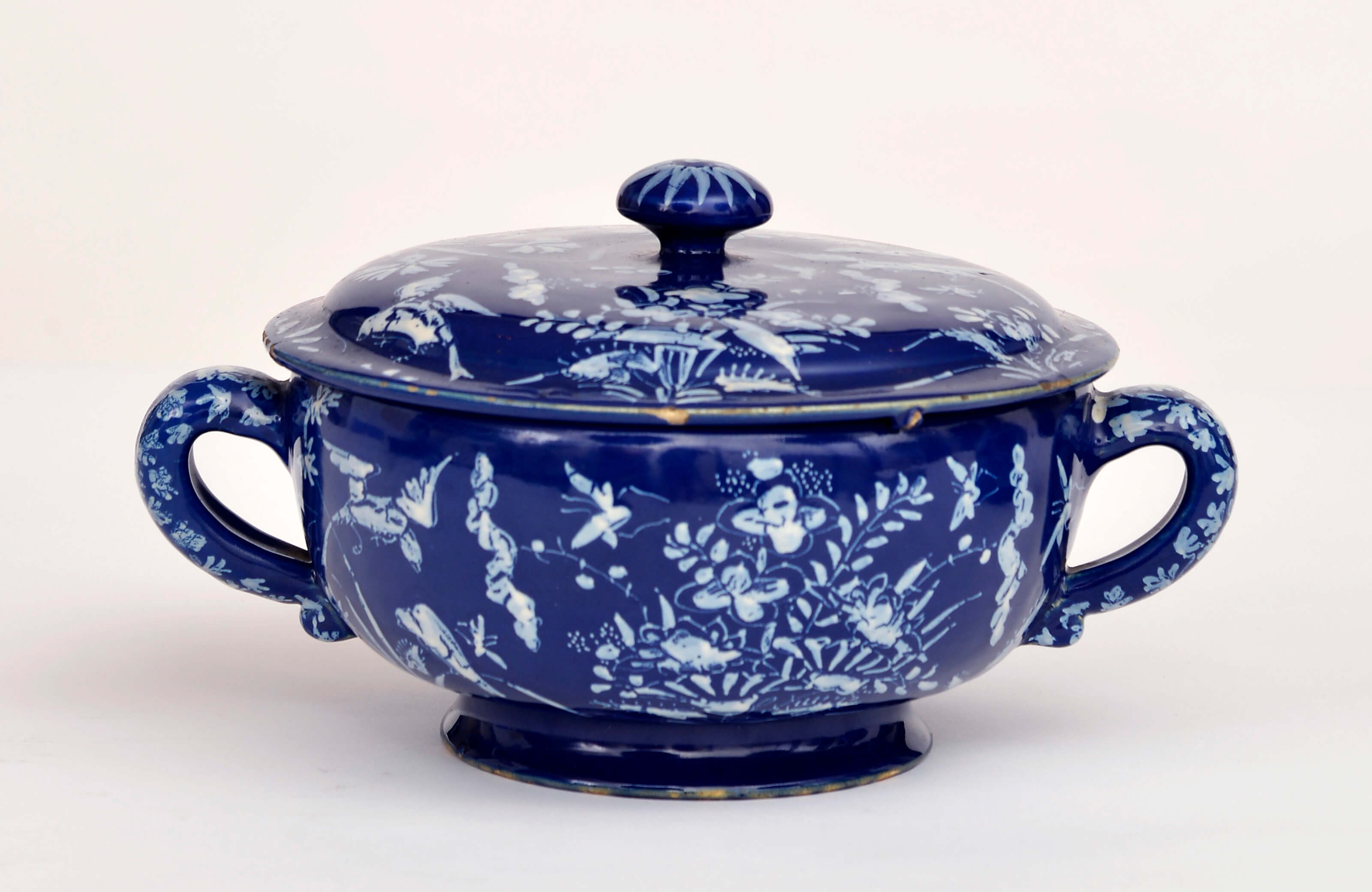
De Paauw (The Peacock) Factory
In 1651 De Paauw (The Peacock) factory was established. Painted on the facade of the building was the founding year and a beautiful blue and black peacock. The symbol became a trademark for the factory and was repeatedly used as a decorative motif on objects. When the factory first opened, it operated with only one oven. By 1729 and again in 1740, two ovens were mentioned in the sales contracts, a testament to the factory’s growth and success over the years.[1]
From 1670 to 1680, the factory had a rapid succession of owners. In fact, the ownership of the factory was divided under several people; in 1663: Willem Cleffius, Gijsbrecht Lambrechtsz. Cruijck, Wouter van Eenhoorn and Leendert van der Let; in 1677: Willem Cleffius, Wouter van Eenhoorn and Leendert van der Leth; in 1679: Willem Cleffius, Lambertus Cleffius and Leendert van der Leth; in 1679 until 1680: Henricus Cleffius, Lambertus Cleffius and Leendert van der Leth.[2]
 From 1680 onwards Petronella van Dijssel operated the factory. Many delicately executed objects were produced during this period. It is for example the case of these very refine sweetmeat dishes from circa 1690. Dishes of this shape, when assembled
as a set of eight surrounding a central star-shaped dish, traditionally were thought to have been made as ‘rijsttafel’ sets. However, the current thinking is that because they have
been found to be referred to in inventories as ‘confituur-starren’ (’preserve sets’), most probably they were used to serve sweetmeats and other delicacies such as dried fruit or summer fruit preserved in brandy.
From 1680 onwards Petronella van Dijssel operated the factory. Many delicately executed objects were produced during this period. It is for example the case of these very refine sweetmeat dishes from circa 1690. Dishes of this shape, when assembled
as a set of eight surrounding a central star-shaped dish, traditionally were thought to have been made as ‘rijsttafel’ sets. However, the current thinking is that because they have
been found to be referred to in inventories as ‘confituur-starren’ (’preserve sets’), most probably they were used to serve sweetmeats and other delicacies such as dried fruit or summer fruit preserved in brandy.
In 1701, the Kam family owned the factory and brought it great success. The factory was jointly operated by father Gerrit Pietersz. Kam and his son master potter David. In 1705 the father donated half of the pottery to his son, which was later settled with his inheritance. David Kam controlled the company for almost fifteen years. When he died in 1719, his widow Margaretha Kam-Oversloot managed the factory. After she died in 1725, the premises, which was described in a sales inventory of 1729 as a very large house with a yard and a spacious pottery factory, was sold.[3]
 Production flourished at De Paauw factory during the twenty years of the Kam ownership. At the end of the seventeenth century, the factory produced blue and white objects designed after transitional and Kangxi porcelain. The family changed course around 1700 with the changing Delft pottery industry. With great inventiveness, the family began making Delftware with a blue ground. They were inspired by the Nevers blue wares, and also the blue berretino grounds on majolica objects and the powdered blue wares that were imported from China to the Republic. This group of unusual Delftware had a blue glaze with a white (or sometimes yellow) oriental decoration with water birds, flowers, lotuses and of course the peacock. The blue ground was a difficult technique, because the decoration could ‘sink’ into the colored ground during firing. At De Paauw factory, they were able to improve the technique, and prevent the glaze from running. The present Persian blue bowl illustrates the exceptional know-how of the factory at the beginning of the eighteenth century. Bowls of this type with the strainer affixed to one side of the interior frequently are referred to as washbowls under the assumption that the strainer was used to hold the soap or a sponge. It has been determined, however, that these were kruidenwijnkommen (herbed wine bowls) for the making and serving of various forms of spiced wine. The bowl would be filled with either red wine (usually port or claret) or even stale beer, and the strainer filled with a variety of spices (such as cloves, nutmeg, cinnamon sticks, mace, cardamom and ginger), raisins or other fruits, and sometimes honey or sugar, and the brew would be left to mull overnight. Surviving pieces of Persian blue pieces are quite rare.[4]
Production flourished at De Paauw factory during the twenty years of the Kam ownership. At the end of the seventeenth century, the factory produced blue and white objects designed after transitional and Kangxi porcelain. The family changed course around 1700 with the changing Delft pottery industry. With great inventiveness, the family began making Delftware with a blue ground. They were inspired by the Nevers blue wares, and also the blue berretino grounds on majolica objects and the powdered blue wares that were imported from China to the Republic. This group of unusual Delftware had a blue glaze with a white (or sometimes yellow) oriental decoration with water birds, flowers, lotuses and of course the peacock. The blue ground was a difficult technique, because the decoration could ‘sink’ into the colored ground during firing. At De Paauw factory, they were able to improve the technique, and prevent the glaze from running. The present Persian blue bowl illustrates the exceptional know-how of the factory at the beginning of the eighteenth century. Bowls of this type with the strainer affixed to one side of the interior frequently are referred to as washbowls under the assumption that the strainer was used to hold the soap or a sponge. It has been determined, however, that these were kruidenwijnkommen (herbed wine bowls) for the making and serving of various forms of spiced wine. The bowl would be filled with either red wine (usually port or claret) or even stale beer, and the strainer filled with a variety of spices (such as cloves, nutmeg, cinnamon sticks, mace, cardamom and ginger), raisins or other fruits, and sometimes honey or sugar, and the brew would be left to mull overnight. Surviving pieces of Persian blue pieces are quite rare.[4]
 Although the factory is mostly renowned for its blue glazes, in the second half of the seventeenth century, the factory was one of the few factories that started experimenting with colors. The vase shows the earliest stages of the development of colored Delftware. Such early polychrome objects are extremely rare. The characteristic color palette of De Paauw factory consists of the colors blue, green and yellow. These grand feu colors were often expanded with red. Red, however, was initially a difficult color for Delftware painters to fire; the metal oxides that gave the color to the glazes could not withstand the high temperatures of the kiln. In order to achieve a red decoration, De Paauw used the cold-painting technique. In this technique, a red lacquer paint was applied to the decoration after the blue, green and yellow paints had been fired.
Although the factory is mostly renowned for its blue glazes, in the second half of the seventeenth century, the factory was one of the few factories that started experimenting with colors. The vase shows the earliest stages of the development of colored Delftware. Such early polychrome objects are extremely rare. The characteristic color palette of De Paauw factory consists of the colors blue, green and yellow. These grand feu colors were often expanded with red. Red, however, was initially a difficult color for Delftware painters to fire; the metal oxides that gave the color to the glazes could not withstand the high temperatures of the kiln. In order to achieve a red decoration, De Paauw used the cold-painting technique. In this technique, a red lacquer paint was applied to the decoration after the blue, green and yellow paints had been fired.
A few objects painted with grand feu colors are also known. The palette of color used for the plate and vase, together with the Persian blue seem to be one of the signature of the factory.
Thus, by creating unusual color schemes, De Paauw factory had been able to establish itself amongst the most talented Delftware factories of the time.
[1] M.S. van Aken-Fehmers, Delfts aardewerk, Geschiedenis van een Nationaal Product, Vol. 2, Gemeentemuseum The Hague, Zwolle, 2001, p. 159.
[2] Ibid, p. 85.
[3] Ibid, pp. 159-160.
[4] For a comprehensive overview of the ‘fonds bleus’ [‘blue grounds’] in Nevers faïence, see Jean Rosen, La faïence de Nevers 1585-1900, Vol. 2: L’Age d’or du XVIIe siècle, Dijon 2009, pp. 43ff. and 290-295.



